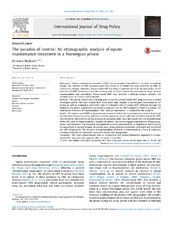| dc.contributor.author | Mjåland, Kristian | |
| dc.date.accessioned | 2016-03-04T13:17:55Z | |
| dc.date.available | 2016-03-04T13:17:55Z | |
| dc.date.issued | 2015-08 | |
| dc.Published | International journal of drug policy 2015, 26(8):781-789 | eng |
| dc.identifier.issn | 0955-3959 | |
| dc.identifier.uri | https://hdl.handle.net/1956/11435 | |
| dc.description.abstract | Background: Opiate maintenance treatment (OMT) is increasingly being offered in prisons throughout Europe. The benefits of OMT in prison have been found to be similar to those produced by OMT in community settings. However, prison-based OMT has been a controversial issue because of fear of the diversion of OMT medications and the development of black markets for prescription drugs such as buprenorphine and methadone. Prison-based OMT thus involves a delicate balance between the considerations of control and treatment. Methods: This article reports on an ethnographic study of a prison-based OMT programme in a closed Norwegian prison. The data include field notes from eight months of participant observation in the prison as well as qualitative interviews with 23 prisoners and 12 prison staff. Midway through the fieldwork, the prison authorities established a separate unit for OMT-enrolled prisoners to reduce the widespread diversion of buprenorphine. This ‘‘natural experiment’’ is explored in the analysis. Results: The prison-based OMT programme was characterised by strict and repressive control to prevent the diversion of buprenorphine, and the control became even stricter after the establishment of the OMT unit. However, the diversion of buprenorphine increased rather than decreased after the establishment of the OMT unit. To understand this ‘‘paradox of control’’, the article engages with theories of legitimacy, power and resistance. The excessive and repressive control was perceived as illegitimate and unfair by the majority of study participants. In various ways, many prisoners protested, confronted and subverted the OMT programme. The increase in buprenorphine diversion is interpreted as a form of collective resistance towards the perceived unfairness of the OMT programme. Conclusion: The article demonstrates that an unbalanced and control-dominated approach to prisonbased OMT may have the opposite effect of what is intended. | en_US |
| dc.language.iso | eng | eng |
| dc.publisher | Elsevier | eng |
| dc.relation.uri | http://www.sciencedirect.com/science/article/pii/S0955395915001310 | |
| dc.rights | Attribution CC BY-NC-ND | eng |
| dc.rights.uri | http://creativecommons.org/licenses/by-nc-nd/4.0/ | eng |
| dc.subject | Opiate maintenance treatment | eng |
| dc.subject | Prison | eng |
| dc.subject | Buprenorphine diversion | eng |
| dc.subject | Control | eng |
| dc.subject | Legitimacy | eng |
| dc.subject | Resistance | eng |
| dc.title | The paradox of control: An ethnographic analysis of opiate maintenance treatment in a Norwegian prison | eng |
| dc.type | Peer reviewed | en_US |
| dc.type | Journal article | en_US |
| dc.date.updated | 2015-12-29T12:59:19Z | |
| dc.description.version | publishedVersion | |
| dc.rights.holder | Copyright 2015 The Author | en_US |
| dc.identifier.doi | https://doi.org/10.1016/j.drugpo.2015.04.020 | |
| dc.identifier.cristin | 1240705 | |
| dc.subject.nsi | VDP::Samfunnsvitenskap: 200::Sosiologi: 220 | |
| dc.subject.nsi | VDP::Social sciences: 200::Sociology: 220 | |

